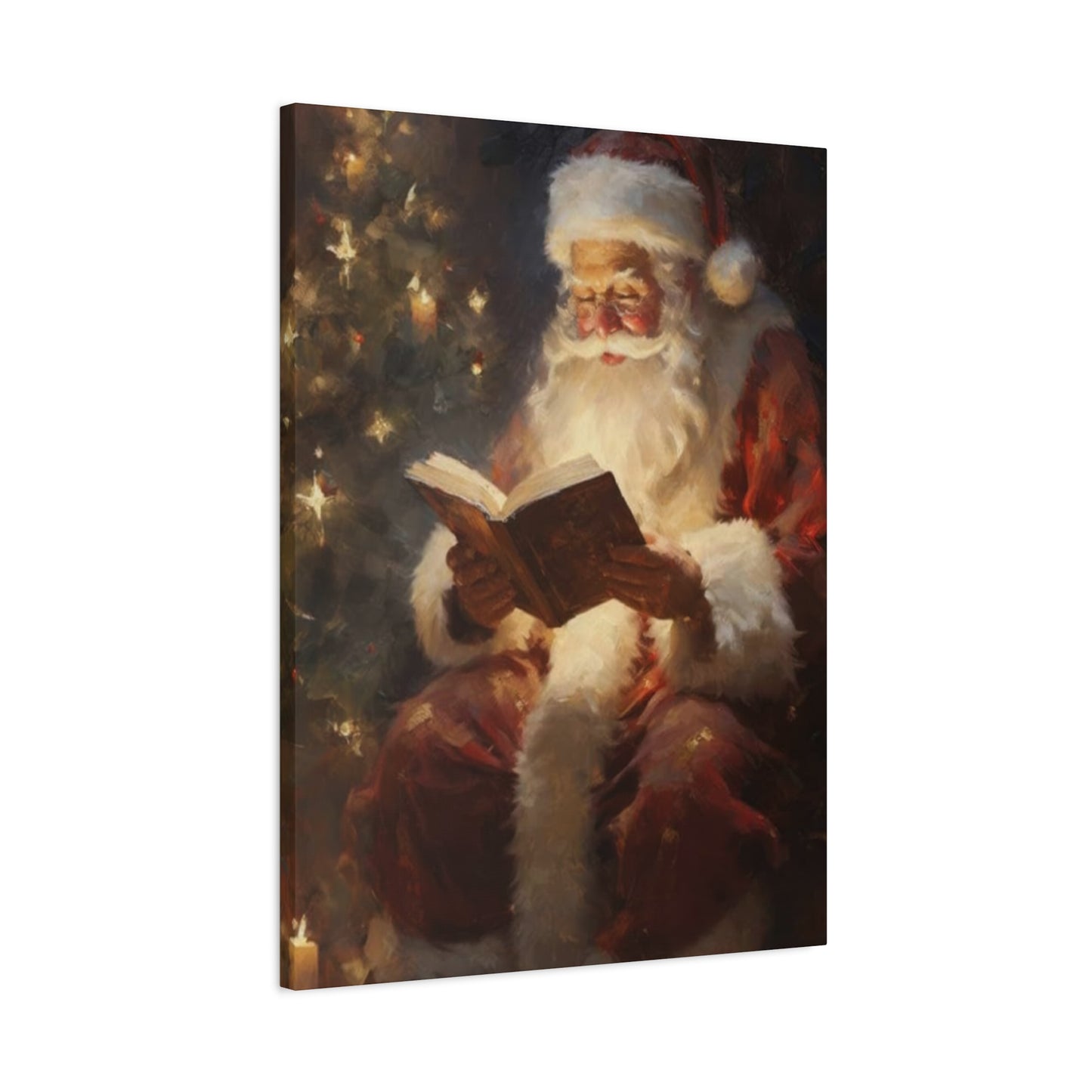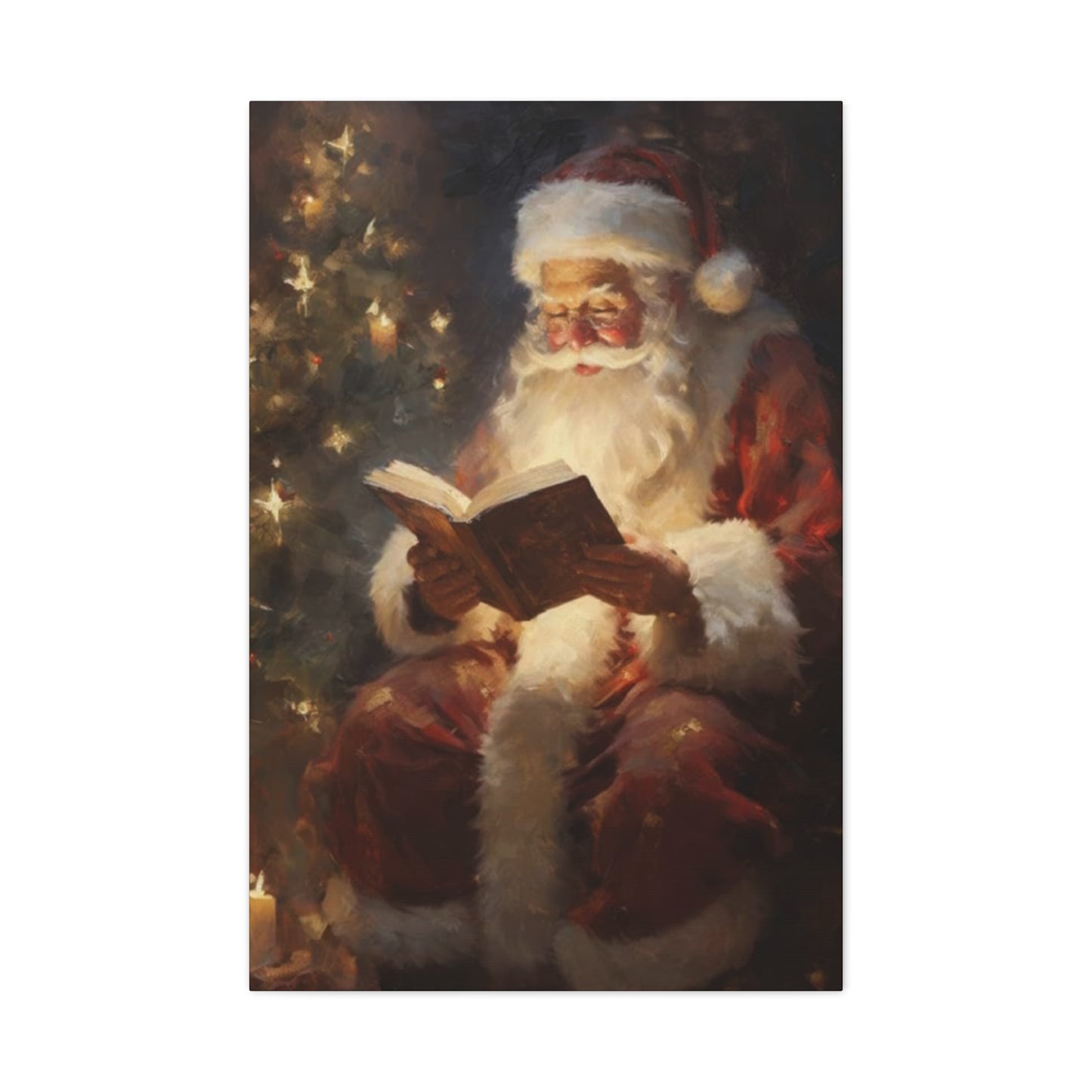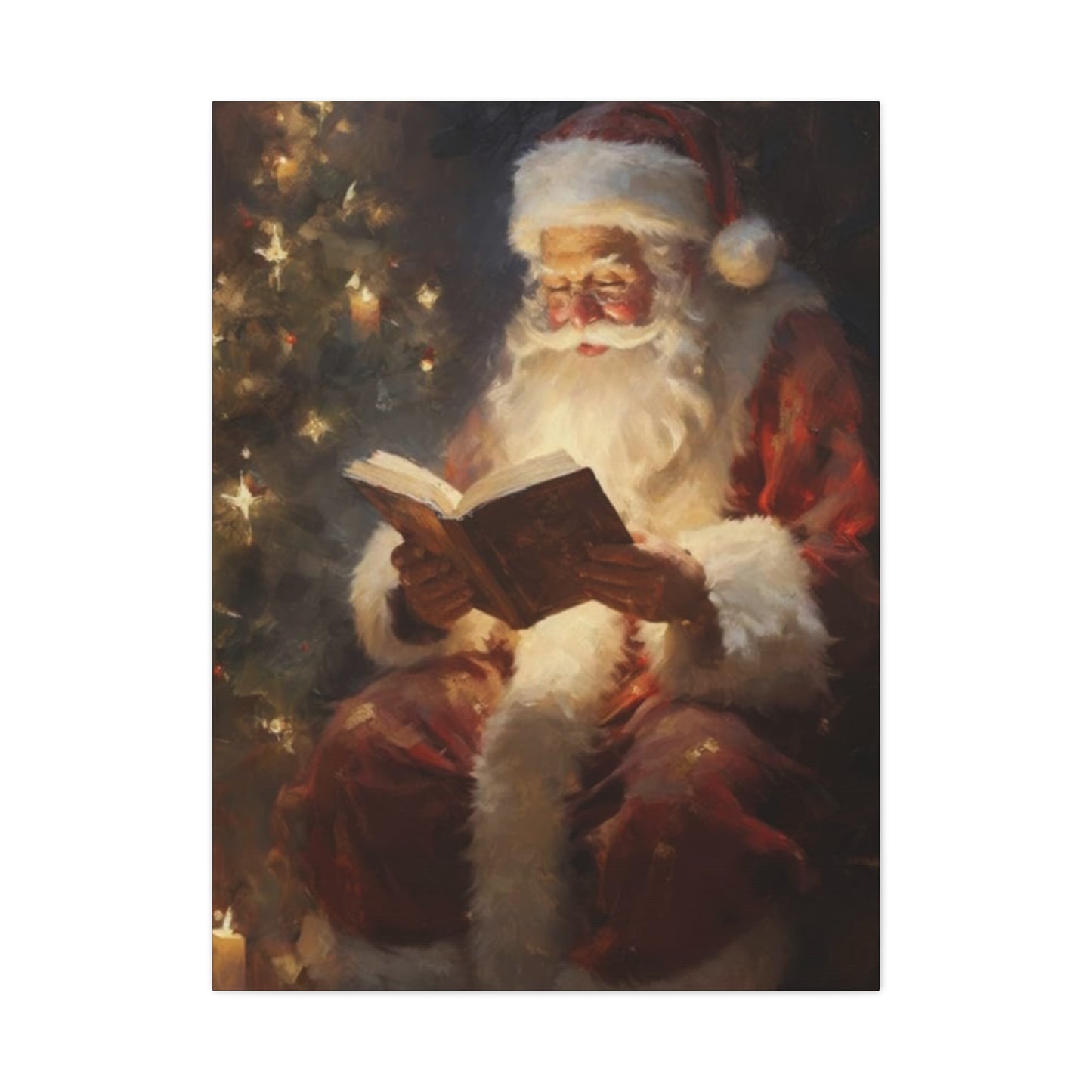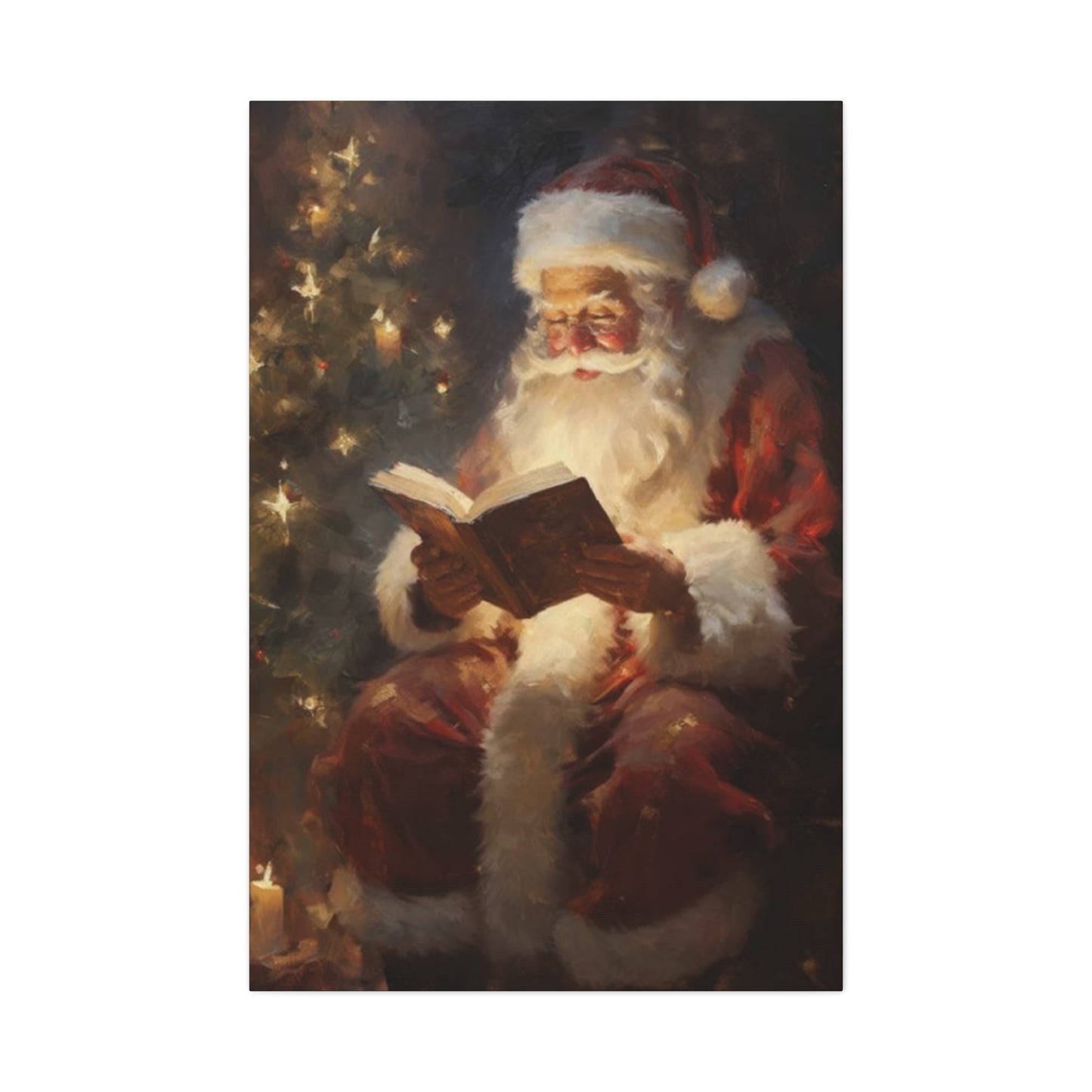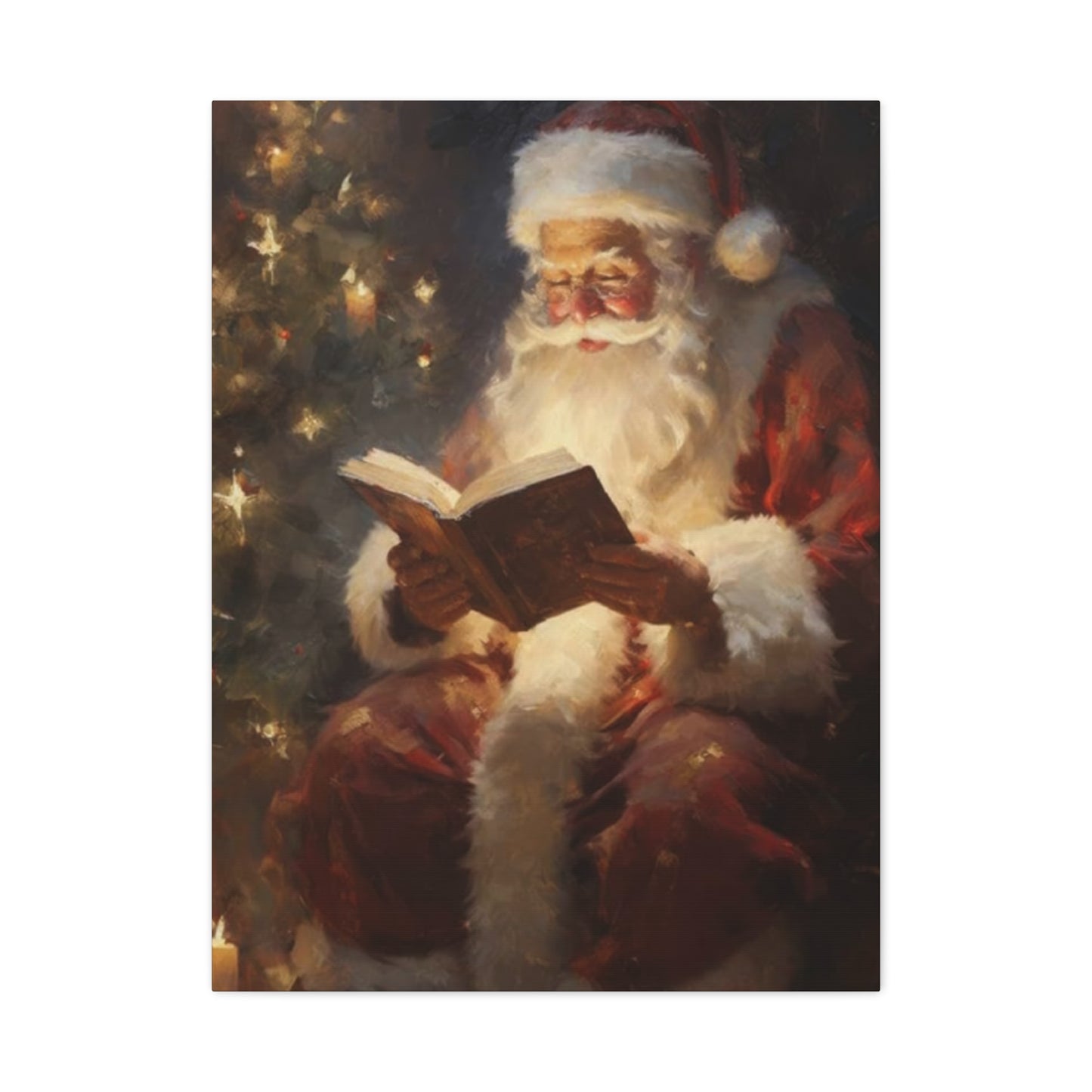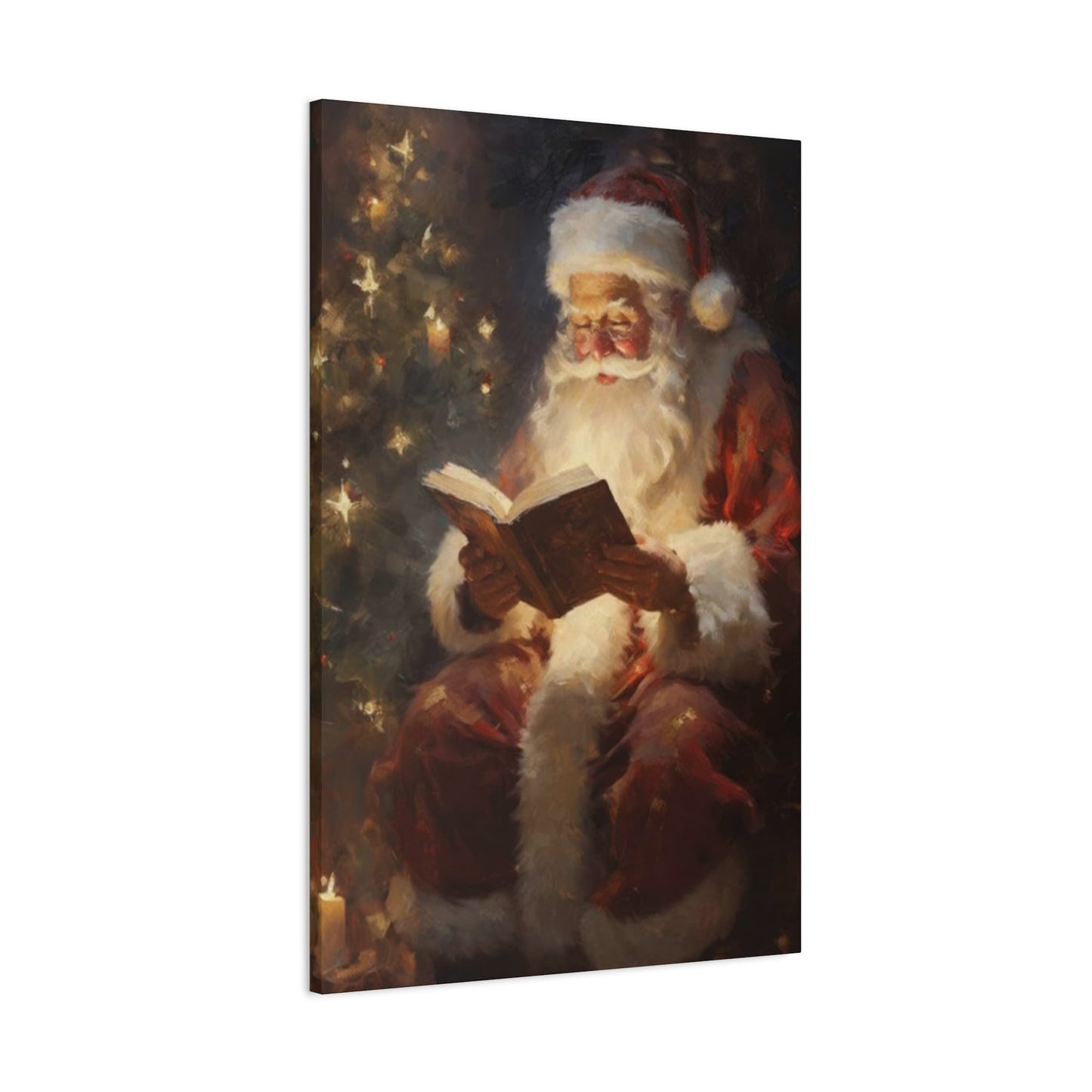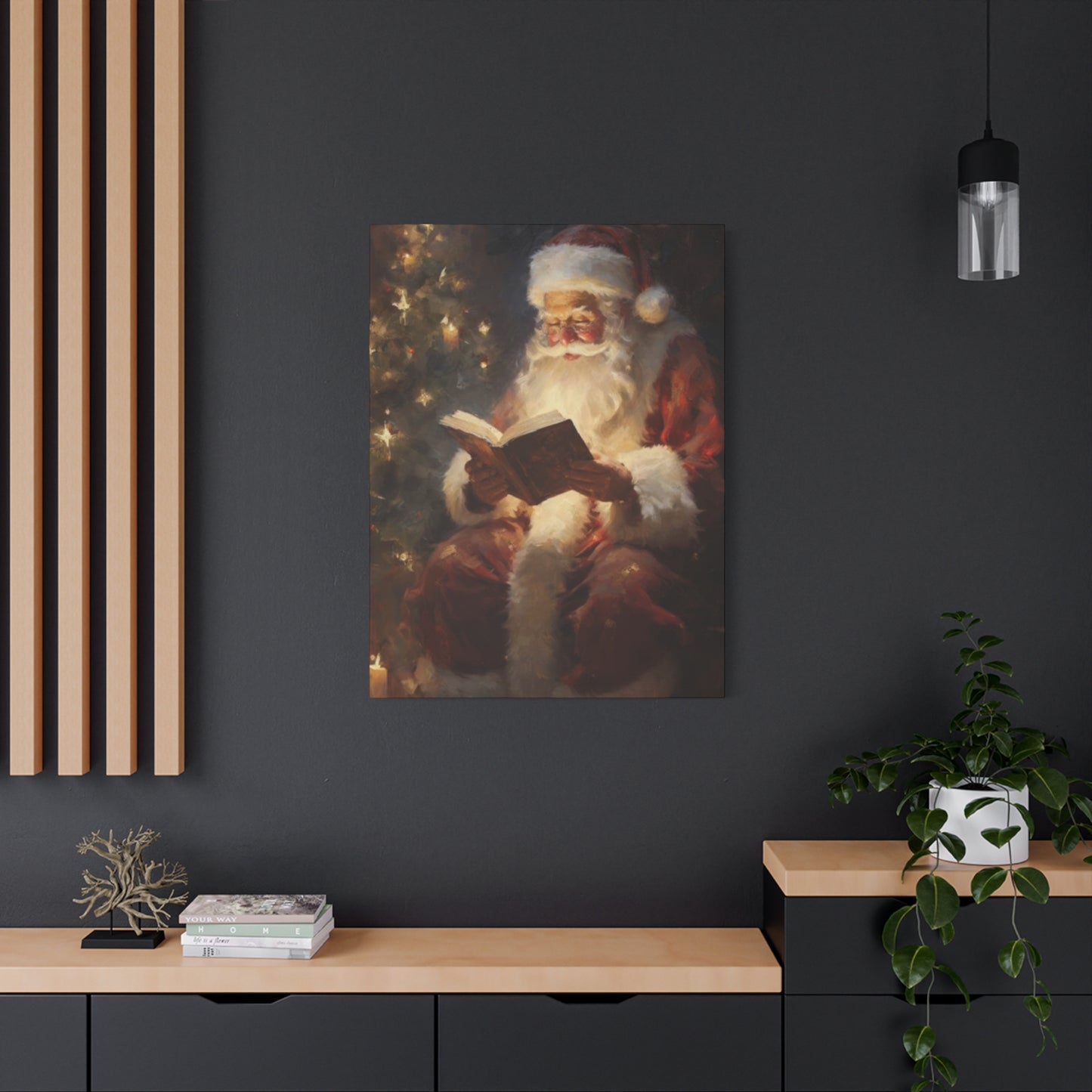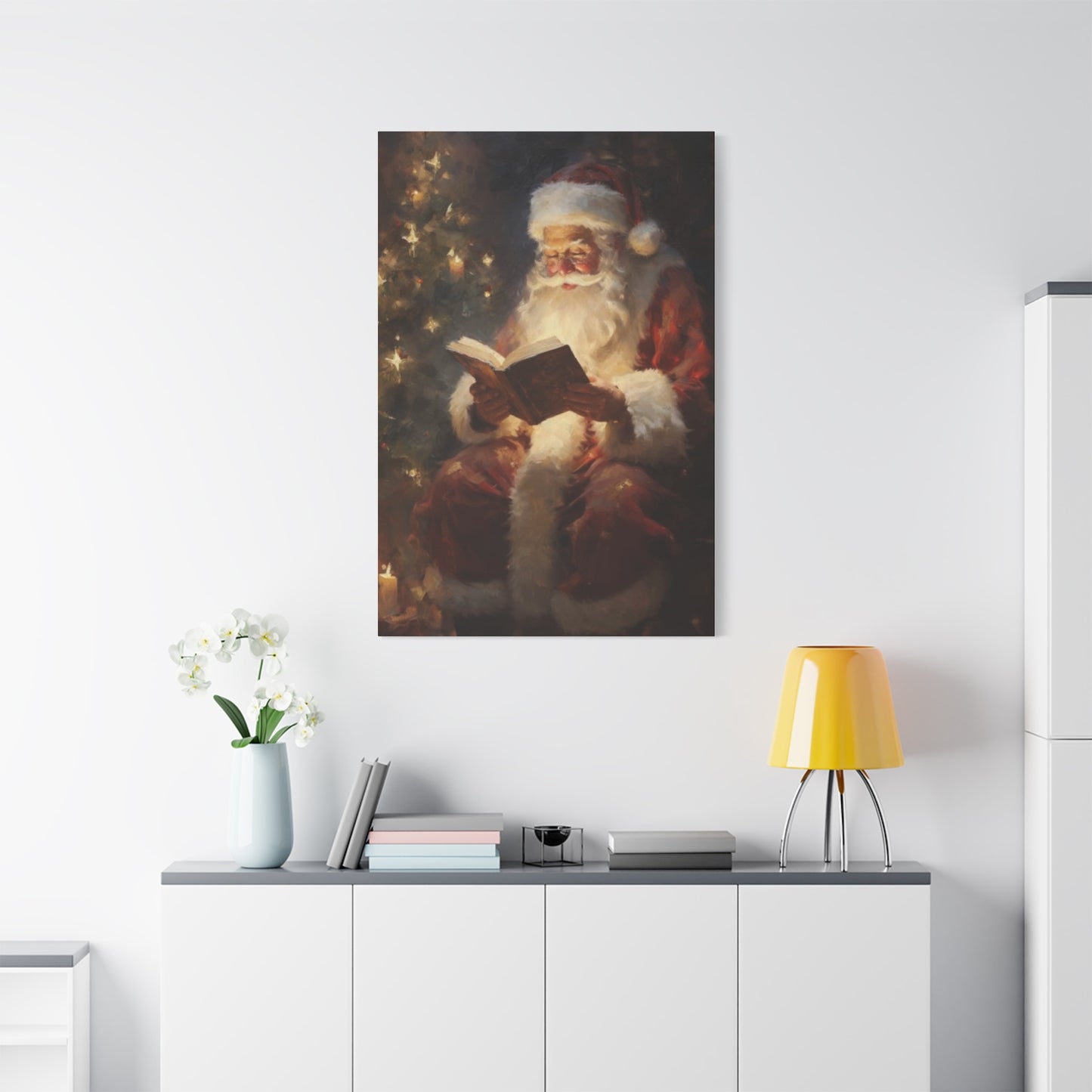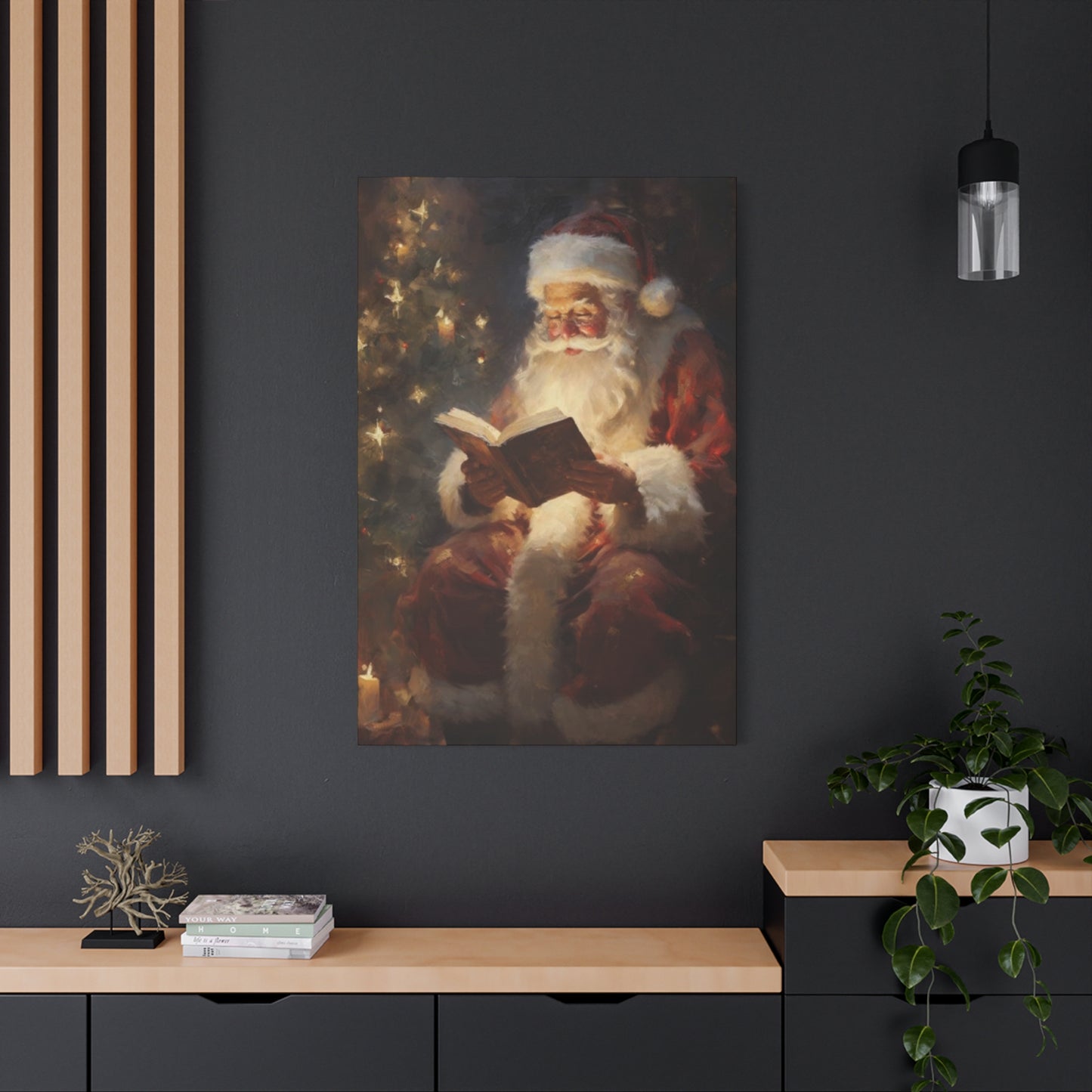Elevating Your Home: The Transformative Power of Santa Claus Holiday Wall Art
The holiday season is a symphony for the senses, a time when homes transform from everyday living spaces into shimmering sanctuaries of warmth and celebration. At the heart of this transformation lies the power of decoration. While garlands, lights, and the central Christmas tree are foundational elements, the walls of a home offer a vast canvas often overlooked. This is where the strategic use of Santa Claus holiday wall art can bridge the gap between mere decoration and true festive elegance. The figure of Santa Claus, universally recognized and cherished, carries with it a potent blend of nostalgia, magic, and goodwill. When captured in art, this figure becomes more than just a seasonal icon; it becomes a focal point, a storyteller, and a powerful tool for curating a sophisticated holiday atmosphere. This exploration delves into the myriad ways that Santa-themed art can elevate your decor, turning your space into a reflection of the season's deepest joys and most elegant possibilities.
Beyond Kitsch: Achieving Festive Elegance with Santa Art
There is a common misconception that incorporating Santa Claus into home decor automatically leans toward the kitschy or juvenile. This, however, is a profound misunderstanding of the potential for festive elegance that this icon holds. The key to elevating Santa art from simple kitsch to a statement of sophistication lies in three areas: the style of the artwork, the quality of the medium, and the context of its placement. To achieve festive elegance, one should look for Santa Claus holiday wall art that possesses a certain artistic merit. This could be a vintage-style portrait with rich, deep colors and a classical composition, reminiscent of Old World painters. It might be a monochromatic sketch or a watercolor piece that uses a restrained palette, focusing on light and shadow rather than bright, cartoonish colors. The medium itself is also critical. A print on stretched canvas with a gallery wrap, a high-quality giclée print in a sophisticated frame, or even a carved wooden plaque adds a level of intentionality and permanence that disposable decorations lack. Context is the final piece of the puzzle. When a beautiful piece of Santa art is placed above a thoughtfully styled mantelpiece, surrounded by fresh greenery, metallic accents, and soft candlelight, it is instantly elevated. It becomes the centerpiece of a curated vignette, not an isolated, childlike afterthought.
Santa Claus Holiday Wall Art as a Generational Tradition
The objects we choose to display in our homes often become imbued with meaning, transforming from mere possessions into cherished heirlooms. Santa Claus holiday wall art is uniquely positioned to become a central part of a family's generational traditions. A specific, high-quality piece of art—perhaps a beautifully framed print, a hand-painted canvas, or a unique carving—can become a symbolic marker for the beginning of the holiday season. The act of unwrapping and hanging this particular piece of art each year becomes a ritual, a stable and predictable moment of joy that children and adults alike can look forward to. This ritualistic aspect is the very foundation of tradition. As children grow up seeing the same elegant Santa portrait hung in a place of honor, they begin to associate that image with the entire spectrum of holiday emotions: anticipation, family togetherness, warmth, and magic. When they grow older and have families of their own, that piece of art carries the weight of all those accumulated memories. It may be passed down, becoming a tangible link to their own childhood and a way to share their family’s unique holiday story with the next generation. This is where the investment in quality art pays emotional dividends.
Integrating Santa Imagery with Sophisticated Design Principles
Integrating the iconic figure of Santa Claus into a sophisticated, well-designed interior requires a thoughtful approach that balances festive spirit with established design principles. It is entirely possible to maintain a home's existing aesthetic—be it minimalist, modern, traditional, or transitional—while incorporating Santa Claus holiday wall art. The first principle to consider is cohesion. The artwork should not fight with the room's established color palette. If your home is decorated in cool, neutral tones, consider a Santa art piece in black and white, sepia, or one that uses muted blues and silvers rather than the traditional bright red. A minimalist space could benefit from a simple line drawing of Santa, while a traditional home can easily absorb a rich, classic oil-painting style portrait. The second principle is scale. A common mistake is using art that is too small, which can look cluttered and insignificant. Conversely, a piece that is too large can overwhelm the space. A large-scale Santa canvas can serve as a stunning focal point above a fireplace or on a primary feature wall, replacing the room's year-round art for the season. Smaller, more intimate pieces can be integrated into gallery walls or styled on bookshelves. The third principle is balance.
The Evolution of Santa Claus in Visual Art
The image of Santa Claus as we know him today is not a static icon but the product of a fascinating evolution through centuries of visual art. Understanding this history can deeply enrich your appreciation for Santa Claus holiday wall art and inform your choices. The figure's origins lie with Saint Nicholas, a 4th-century Greek bishop from Myra, in modern-day Turkey. Early artistic depictions, common in Byzantine and medieval religious art, show a tall, thin, and solemn man in traditional bishop's vestments, often holding three gold balls or a bag of coins to represent his legendary generosity. He was a figure of piety and stern benevolence. This image of Saint Nicholas as a religious figure dominated for centuries. The transformation into the jolly, secular "Santa Claus" was a gradual process. Dutch settlers brought the legend of "Sinterklaas" (a contraction of Sint-Nicolaas) to New Amsterdam (now New York). He was still a bishop-like figure but was also depicted smoking a pipe and flying over rooftops. The true turning point came in the 19th century. Clement Clarke Moore's 1823 poem "'Twas the Night Before Christmas" famously described him as a "jolly old elf." This inspired illustrators, but it was Thomas Nast, a cartoonist for Harper's Weekly, who, in a series of drawings starting in the 1860s, cemented the modern image: a plump, cheerful, bearded man in a red, fur-trimmed suit, living at the North Pole.
Why Wall Art is a Focal Point for Holiday Transformations
In the hierarchy of holiday decorating, wall art plays a uniquely powerful role in transforming a space. While other decorations like ornaments, textiles, and tabletop items add layers of festive texture, wall art has the ability to instantly and dramatically set the theme, mood, and color palette of an entire room. It serves as a visual anchor. When you enter a space, your eye is naturally drawn to vertical surfaces, particularly the largest and most prominent walls. Placing a significant piece of Santa Claus holiday wall art in this prime location, such as over a fireplace, sofa, or buffet, immediately establishes a focal point. This single action can communicate the room's entire holiday "story." It tells guests whether the theme is nostalgic and traditional, modern and playful, or rustic and cozy. This anchoring effect helps to unify all the other, smaller decorative elements. The colors in the Santa painting can be picked up in the throw pillows, the style of the art can be echoed in the mantel decor, and the mood it evokes can be enhanced by the room's lighting and music. Unlike smaller decorations that can get lost in the seasonal "clutter," wall art commands attention and provides a clear center of gravity for the entire design.
Exploring Classic and Vintage Santa Claus Portraits
There is an undeniable charm and depth to classic and vintage Santa Claus portraits that make them a cornerstone of achieving festive elegance. This style of Santa Claus holiday wall art taps directly into a senseDof nostalgia and tradition, evoking the "Christmas card" aesthetic of the early to mid-20th century. These portraits are often characterized by their rich, saturated color palettes—deep crimson reds, forest greens, and creamy whites, often set against a dark, shadowy background that makes the figure of Santa pop. The artists of these eras, heavily influenced by classical portraiture and illustrators like Norman Rockwell, focused on capturing a specific mood. The Santa in these pieces is rarely cartoonish; he is depicted with a sense of weight, wisdom, and benevolence. His eyes often twinkle with a knowing kindness, and his beard is rendered with realistic texture. The focus is on the face, capturing a moment of quiet joy, thoughtful contemplation, or a gentle "shush" to the viewer. These pieces are often available as high-quality canvas or giclée prints, which preserve the texture and color fidelity of the original oil or watercolor paintings. When framed, they take on an even greater sense of importance. A distressed gold or dark wood frame can enhance the vintage feel, making the art look like a cherished family heirloom. Displaying a classic Santa portrait over a traditional fireplace, surrounded by real evergreen garlands and brass candlesticks, creates an atmosphere of timeless, sophisticated warmth that is difficult to achieve with more modern styles.
Modern and Abstract Interpretations of Santa Art
For those whose home decor leans contemporary, minimalist, or eclectic, the world of modern and abstract Santa Claus holiday wall art offers exciting possibilities. This genre breaks free from traditional representation, reinterpreting the Santa icon through the lens of modern art principles. Instead of a detailed, realistic portrait, a modern piece might use bold geometric shapes to suggest the form of Santa—a red triangle for the hat, a white cloud for the beard, and a red block for the suit. Color becomes a primary tool; a piece might feature the traditional red and white but add unexpected pops of teal, magenta, or even metallics. Abstract interpretations take this even further, focusing on the feeling of Santa rather than his literal image. This could be an abstract expressionist canvas dominated by swirling reds, whites, and golds, evoking the energy and motion of his Christmas Eve ride. It could be a minimalist piece that features nothing but the iconic red hat set against a stark white background. These modern and abstract works function beautifully as sophisticated design elements. They act as a conceptual nod to the season rather than a literal depiction. This subtlety is key to their elegance. They integrate seamlessly into non-traditional holiday color palettes and minimalist spaces, providing a touch of festive spirit without disrupting the home's carefully curated aesthetic. This style of Santa art appeals to those who appreciate art as a conversation starter and who want their holiday decor to reflect their personal, contemporary taste.
Rustic and Farmhouse-Style Santa Claus Wall Decor
The rustic and farmhouse aesthetic, with its emphasis on natural materials, cozy textures, and a sense of history, provides a perfect backdrop for a specific style of Santa Claus holiday wall art. This decor theme is all about warmth, simplicity, and authenticity, and the Santa art that fits within it reflects these same values. Instead of a glossy print, think in terms of texture. A popular choice is Santa's image printed or painted directly onto reclaimed wood planks. The imperfections of the wood—the grain, the knots, the distressed paint—add a layer of history and tactile appeal that feels perfectly at home in a farmhouse setting. These pieces often feature a more "folk art" style Santa, one who looks less like a polished commercial icon and more like a woodsman or a humble gift-giver. The color palette is often more muted, featuring barn reds, antique whites, and earthy browns. Another excellent option is art painted on burlap or linen, which can be hung as a simple scroll or stretched over a frame. Framed art also works beautifully, especially when the frame itself is a statement piece made of distressed barnwood or simple, raw pine. To integrate this art with festive elegance, the key is layering. A wooden Santa sign can be hung on a shiplap wall and then layered with a garland of real cedar or pine, accented with pinecones and simple burlap ribbon. This style of Santa art isn't about high-gloss perfection; it's about creating a feeling of lived-in, unpretentious, and heartfelt holiday cheer.
Whimsical and Playful Santa Art for Family Spaces
While sophistication and elegance are primary goals for many parts of the home, there are spaces—like children's bedrooms, playrooms, or family dens—where whimsy and playfulness are paramount. This is where whimsical Santa Claus holiday wall art truly shines. This style captures the pure, unadulterated magic and fun of the Santa legend. These pieces often feature Santa in more dynamic and narrative poses: him winking cheekily at the viewer, tangled in Christmas lights, checking his long list (with a magnifying glass), or even depicted as a cheerful, simplified illustration. The color palettes are typically brighter and more varied than in traditional portraits, incorporating vibrant blues, pinks, and greens alongside the classic red and white. The art style itself often borrows from children's book illustrations, with softer lines, exaggerated features, and a clear emphasis on storytelling. A piece might show Santa with his elves in a bustling workshop or laughing with his reindeer. This type of art is incredibly effective at creating an atmosphere of joy and anticipation, especially for the younger members of the household. It validates their excitement and visually reinforces the magical stories of the season. To keep it from feeling cluttered, choose one or two larger, high-quality pieces rather than many small ones. A large, beautifully illustrated canvas of Santa and his sleigh can become the centerpiece of a child's room during the holidays, a magical image to look at before falling asleep on Christmas Eve. This playful approach is a vital part of a well-rounded holiday decor strategy, ensuring the fun of the season is celebrated with as much intention as its elegance.
Minimalist Approaches to Santa Claus Holiday Wall Art
Minimalism, a design philosophy centered on "less is more," may seem at odds with the often-opulent nature of holiday decorating. However, a minimalist approach to Santa Claus holiday wall art can result in a look that is incredibly sophisticated, intentional, and full of festive elegance. This style strips the Santa icon down to its most essential elements. It avoids the clutter of detailed scenes or heavy ornamentation, focusing instead on form, line, and negative space. A perfect example is a simple, continuous-line drawing of Santa's profile, including his beard and hat, rendered in black ink on a crisp white background, and placed in a simple, thin black or natural wood frame. This single piece can make a powerful yet understated festive statement in a minimalist living room. Another approach is to use color blocking. Imagine a diptych or triptych of small canvases: one solid panel of Santa's signature red, one of pure white, and perhaps one of a deep forest green, conceptually representing the holiday palette without any literal imagery at all, save for a tiny, embossed Santa hat in the corner of one. Typographic art also fits well here, with a simple, elegant font spelling out a classic Santa-related phrase like "He sees you when you're sleeping" or just "St. Nick" on a clean background. The key to minimalist Santa art is its subtlety. It's a quiet nod to the season, relying on clean lines and a restrained palette to evoke the holiday spirit without overwhelming the senses.
The Charm of Norman Rockwell-Inspired Santa Illustrations
Norman Rockwell, though he did not invent the modern Santa, arguably did more than almost any other 20th-century artist to infuse the image with a distinctly American sense of narrative and nostalgic charm. His Santas, famously featured on the covers of The Saturday Evening Post, are not just static portraits; they are snapshots of a story in progress. They capture the humanity, humor, and gentle exhaustion of the "man behind the suit." Rockwell's Santas are often depicted in relatable, behind-the-scenes moments: checking his list with a look of intense concentration, asleep in a chair after his long night's work, or being discovered by a wide-eyed child. This storytelling element is the core of its charm. When you select Santa Claus holiday wall art inspired by this style, you are bringing that narrative warmth into your home. These illustrations are celebrated for their incredible detail, expressive faces, and the perfect capture of a fleeting moment. They excel at evoking a specific, wholesome, mid-century American feeling. This style of art is the epitome of classic tradition and works exceptionally well in family rooms, dens, or kitchens. A high-quality print of a Rockwell-esque Santa illustration, framed simply, invites viewers to come closer and examine the details of the scene. It becomes a conversation piece, prompting stories and shared memories. This art achieves a unique form of festive elegance that is rooted in emotion, storytelling, and a deep, comforting sense of nostalgia.
Victorian Era Santa Claus Artistry and Its Elegance
For a look of deep, historical, and slightly mystical elegance, turning to Victorian-era depictions of Santa Claus can be a stunning choice. The Victorian period (1837-1901) was a time when many Christmas traditions were being formalized, and the imagery of Santa (or Father Christmas, as he was often called in Britain) was still in flux. This results in a fascinating and often beautiful variety of artistic interpretations. Victorian Santa Claus holiday wall art often features a figure who is more slender and ethereal than the robust Santa we know today. He is frequently depicted in long robes rather than a "suit," and these robes were not always red; it was just as common to see him in green, blue, or brown, symbolizing his connection to nature, winter, and the pre-Christian figure of the Holly King. These Santas often have a more solemn, patriarchal, or "Old World" demeanor, reminiscent of Saint Nicholas. They might be shown carrying a sprig of holly, a wassail bowl, or a small, simple Christmas tree, reflecting the traditions of the time. The artwork itself often has a rich, detailed, and sometimes gothic quality, with intricate line work and deep, moody color palettes. A framed print of a Victorian Father Christmas, with his long, flowing beard and star-topped staff, adds an immediate sense of history and gravitas to a holiday display. It pairs beautifully with velvet ribbons, dark wood furniture, and the glow of candlelight, creating a sophisticated and enchanting atmosphere that feels both ancient and deeply festive.
The Richness of Canvas Prints for Santa Claus Art
When selecting your Santa Claus holiday wall art, the medium on which the image is presented is just as important as the image itself. Canvas prints have become a dominant and highly effective choice for achieving a look of substance and festive elegance. Unlike a standard paper print, a canvas print has a tangible texture that adds depth and a "painterly" quality to the artwork, even if it's a photographic or digital reproduction. This texture, mimicking that of an original oil or acrylic painting, interacts with light in a more dynamic way, preventing the harsh glare that can sometimes come from art framed behind glass. This tactile quality lends the art a sense of permanence and high value. One of the most popular and sophisticated presentations is the gallery-wrapped canvas, where the canvas is stretched around a sturdy wooden frame, and the image continues around the edges. This creates a clean, modern, and frameless look that floats on the wall, allowing the art to stand on its own without the distraction of a frame. Alternatively, a canvas print can be placed within a "floater" frame, which leaves a small gap between the canvas edge and the frame, creating a contemporary, museum-quality effect. The richness of a canvas print makes it an ideal choice for a focal point piece, such as a large Santa portrait above the mantel or sofa. It has the visual weight to anchor a room's holiday decor and signals a serious, curated approach to decorating.
Framed Santa Art: Choosing the Right Frame for Elegance
The power of a frame to transform a piece of art cannot be overstated. When it comes to Santa Claus holiday wall art, the right frame is what can elevate a simple print into a truly elegant and intentional decor element. The frame acts as the finishing touch, the "jewelry" for the artwork, and it must be chosen in harmony with both the art itself and the room's existing style. For a classic or vintage Santa portrait, a more ornate frame can be magnificent. Consider a substantial wood frame with carved details, or a metallic frame in a distressed gold or antique silver finish. This type of frame adds weight and a sense of history, enhancing the timeless quality of the artwork. It works particularly well in traditional, transitional, or formal living and dining rooms. For a modern or minimalist piece of Santa art, such as a line drawing or an abstract interpretation, the frame should be the opposite: simple, clean, and unobtrusive. A thin, gallery-style frame in black, white, or a natural wood like maple or light oak will provide a crisp border without competing with the art. This clean look emphasizes the artwork itself and aligns perfectly with a contemporary aesthetic. In a rustic or farmhouse setting, a frame made of reclaimed barnwood or one with a simple, distressed white or black finish will complement the textured, cozy feel of the decor. The key is to see the frame and art as a single, cohesive unit designed to enhance your space's festive elegance.
The Modern Appeal of Metal Santa Claus Wall Art
For a truly contemporary, durable, and eye-catching holiday statement, metal Santa Claus holiday wall art offers a unique and compelling alternative to traditional mediums. This style involves infusing dyes directly into a sheet of specially coated aluminum. The result is not a print on metal, but a print in metal. This process yields stunning visual benefits. First and foremost is the vibrancy and luminescence. The metallic surface reflects light in a way that paper and canvas cannot, making colors appear incredibly saturated, bright, and almost backlit. A Santa's red suit will look deeper and richer, and any white areas, like his beard or snow, will have a crisp, brilliant sheen. This high-gloss, luminous quality makes metal art a showstopper, perfect for a modern, glam, or transitional home. The second benefit is its sleek, frameless profile. Metal prints are typically mounted with a "floating" bracket on the back, allowing them to hang about an inch off the wall. This creates a subtle, elegant drop shadow and a sense of depth, making the art appear to float. This clean, borderless presentation is inherently modern. Finally, metal prints are exceptionally durable. They are waterproof, scratch-resistant, and easy to clean, making them a practical choice for high-traffic areas like entryways or even covered porches. This modern medium can take any style of Santa image, from a vintage portrait to a digital design, and give it an immediate contemporary edge.
Wooden Santa Plaques and Carved Wall Hangings
There is an earthy, tactile warmth to wooden Santa plaques and carved wall hangings that connects the holiday season back to its natural, wintery roots. This style of Santa Claus holiday wall art is a cornerstone of rustic, farmhouse, and primitive decorating styles, offering a sense of handcrafted authenticity. These pieces move beyond a simple two-dimensional image and into the realm of sculpture and mixed media. Carved Santa wall hangings are often made from a single piece of wood, with the artist using high-relief or low-relief carving techniques to give Santa's face, beard, and hat a tangible, three-dimensional form. These pieces are often hand-painted, with a focus on simple color palettes and finishes that allow the wood grain to show through. The result is a piece of folk art, where the artist's hand is clearly visible. Wooden plaques, on the other hand, often use a flat, solid piece of wood—sometimes reclaimed, like barnwood, or a cross-section "slice" of a log—as the canvas. The Santa image is then painted on, sometimes with a distressed or antiqued finish to make it look like a vintage sign. These pieces often incorporate text, like "Merry Christmas" or "Believe." The appeal of wood lies in its organic imperfection. The knots, the rough-hewn edges, and the natural grain provide a textural contrast to the softer elements of holiday decor, like textiles and greenery. Hanging a wooden Santa plaque in a kitchen or entryway instantly creates a welcoming, unpretentious, and cozy atmosphere.
Creating a Welcoming Entryway with Santa Wall Art
The entryway, or foyer, is the home's first impression. It's the transitional space that welcomes guests in from the cold and sets the tone for the entire festive experience within. Using Santa Claus holiday wall art in this area is a powerful way to make an immediate, warm, and celebratory statement. The key in an entryway is to choose art that is both impactful and appropriate for the scale of the space. In a smaller entryway, a single, beautifully framed Santa portrait or a tall, narrow wooden plaque can add a festive touch without overwhelming the area. Consider a "welcoming" Santa, one who is smiling, holding a lantern, or has his arms open. This pose subconsciously reinforces the feeling of hospitality. In a larger foyer with a feature wall, you have the opportunity to be bolder. A large-scale canvas print of a classic Santa can serve as a stunning focal point, drawing guests in. Pairing the art with other elements amplifies its effect. Place a console table beneath the Santa art and style it with a bowl of pinecones, a pair of elegant candlesticks, and a small, fragrant evergreen arrangement. If the art is illuminated, either from within or with a picture light, it will cast a warm, inviting glow, which is especially effective during the dark evenings of winter. This thoughtful combination of art and styling in the entryway ensures that the magic of the season and the feeling of festive elegance begin the very moment someone steps through your front door.
Santa Claus Holiday Wall Art as a Living Room Centerpiece
The living room is often the heart of holiday gatherings, the space where the tree stands, stockings are hung, and families convene. As such, the wall art in this room bears the most responsibility for establishing the central holiday theme and achieving a cohesive look. Using a significant piece of Santa Claus holiday wall art as a living room centerpiece, particularly above the fireplace mantel, is a classic and highly effective strategy. The mantel is the natural focal point of the room, and placing a large, high-quality Santa portrait here gives it a place of honor. This single piece can dictate the entire room's decor. The colors in the painting—the specific shade of red in his suit, the gold buckles, the deep green of a toy bag—can be extracted and repeated in throw pillows, blankets, and ornaments on the tree. If the art is a vintage-style Santa, the room's decor can lean into that nostalgia with traditional garlands and classic carols. If the art is a modern, abstract Santa, the tree might be decorated with minimalist, geometric ornaments. Beyond the mantel, a large, empty wall, such as the one behind the main sofa, is another prime location. A large horizontal canvas or a triptych of Santa-themed art can create a stunning backdrop for all your holiday activities. The goal is to choose a piece with enough scale and artistic merit to command attention, allowing it to anchor the space and tie all the other festive elements together in a display of true festive elegance.
Festive Elegance in the Dining Room for Holiday Feasts
The dining room transforms during the holidays into a stage for the season's most memorable feasts and celebrations. The decor in this space should aim to create an atmosphere that is both festive and sophisticated, a backdrop that enhances the experience of a shared meal. Santa Claus holiday wall art can play a pivotal role in achieving this specific ambiance. Unlike the playful art that might suit a family room, dining room art often benefits from a more formal or classic tone. A large, Old World-style Santa portrait, perhaps a reproduction of a Victorian painting, can add a sense of timeless elegance. A framed piece depicting a serene, snowy scene with Santa's sleigh in the distance can be both festive and tranquil. The placement is key. A buffet or sideboard is an ideal location for a large framed piece, which can be flanked by tall, tapering candles or silver reindeer figurines. On the main dining wall, a gallery wall of smaller, cohesively framed holiday art, with a classic Santa sketch as the centerpiece, can create a sophisticated, curated look. The lighting in the dining room is crucial; ensure your Santa art is well-lit, perhaps by a picture light or the soft glow from the chandelier. The art sets the mood. A piece with rich, deep colors like burgundy, navy, and gold will contribute to a dramatic and intimate dining experience, perfectly complementing the festive table setting and the warmth of the gathered company.
Cozy Kitchen Decor: Incorporating Santa Art
The kitchen is the engine room of the holiday season, a place of warmth, delicious aromas, and bustling activity. It's often where family and guests congregate, making it a perfect, albeit sometimes overlooked, place for festive decoration. Incorporating Santa Claus holiday wall art into the kitchen can enhance this cozy, communal feeling. Given that kitchens are working spaces, the art should be practical and placed thoughtfully. Smaller, more whimsical pieces often work best. A small, framed print of a "baking Santa" (perhaps holding a cookie) or a vintage-style Santa advertising cocoa can be a charming addition to a backsplash area or an open shelf. Wooden plaques or small, painted signs are particularly well-suited for the kitchen environment. Their rustic, durable nature fits the "heart of the home" aesthetic, and they are less precious than a fine art canvas. A smaller wooden Santa plaque can be hung on the side of a cabinet, on a pantry door, or as partof a small gallery wall on an empty breakfast nook wall. The key is to add a touch of cheer without creating clutter. These small pops of Santa art serve as cheerful "Easter eggs" for people to discover as they move through the space. They are a reminder that the holiday spirit isn't just reserved for the formal areas of the home but is woven into the everyday, functional spaces where the real work and warmth of the season happen.
Whimsical Santa Decor for Children's Bedrooms
Decorating a child's bedroom for the holidays is a special opportunity to create a truly magical and personal wonderland. This is the one space in the home where whimsy can, and should, take center stage. Santa Claus holiday wall art for a child's room should be focused on storytelling, bright colors, and sparking the imagination. Look for art that captures the narrative of Santa's magic. Pieces depicting Santa and his reindeer flying through the night sky, Santa checking his list, or Santa placing gifts under a tree are all wonderful choices. Illustrations that show Santa interacting with woodland creatures or elves add to the storybook feel. The style should be approachable and joyful. Soft, watercolor illustrations, bright and cheerful digital art, or cute, cartoon-style Santas are all excellent. This is also a wonderful place for illuminated art. A canvas print with tiny, embedded LED lights that make the stars or the reindeer's noses twinkle can be a truly enchanting addition, serving as both art and a festive nightlight. The placement of the art is important; hang it where the child can easily see it from their bed, making it one of the last things they see at night and one of the first things they see in the morning. This type of decor isn't just about festive elegance; it's about actively building the magic of the season and creating cherished core memories of Christmas wonder for your child.
Creating a Gallery Wall of Holiday Art
A gallery wall is a fantastic, curated way to showcase multiple pieces of art and tell a cohesive story. Creating a holiday-themed gallery wall, with Santa Claus holiday wall art as the anchor, is a sophisticated method for displaying a collection of smaller festive pieces. This approach allows you to blend different styles, mediums, and sizes into one harmonious display. To begin, select your "hero" piece. This will be the largest or most prominent item, and a classic Santa portrait or a striking modern interpretation works perfectly. This piece will anchor the entire collection. Next, build around it with smaller works. You can mix and match a varietyindof items: a framed vintage Christmas card, a small canvas print of a snowy landscape, a typographic piece with a festive quote, and a simple sketch of a reindeer. The key to making this eclectic mix look like a display of festive elegance is to create unity. This is most easily achieved through framing. By using the same color frame (e.all black, all gold, or all white) for all the different pieces, you create a visual rhythm and a clean, intentional look, even if the art styles vary.
Lighting Your Santa Claus Art for Maximum Impact
Proper lighting is a critical, yet often forgotten, element in interior design that can make the difference between a nice decoration and a truly stunning focal point. When you have invested in a beautiful piece of Santa Claus holiday wall art, lighting it correctly will enhance its colors, details, and overall impact, maximizing its contribution to your home's festive elegance. There are several effective methods. The most professional and dramatic option is a dedicated picture light. This is a small, linear light fixture mounted on the wall directly above the artwork, casting a focused, even glow across its surface. This is ideal for a significant focal point piece, like a large canvas over the mantel. It treats the Santa art with the same respect as a fine painting in a gallery, drawing the eye to it and making the colors pop, especially in the evening. For a simpler, more flexible approach, consider using angled spotlights. If you have recessed ceiling lights, you can often outfit them with an "eyeball" or "gimbal" trim that allows you to direct one of the lights specifically toward the artwork.
Coordinating Santa Art with Your Christmas Tree Theme
The Christmas tree is the undeniable anchor of holiday decor, and for a truly cohesive and sophisticated look, your other decorative elements, including your Santa Claus holiday wall art, should be in conversation with it. Coordinating your art and your tree creates a powerful, unified theme that demonstrates intentional design and festive elegance. The most direct way to do this is through color. If your tree is decorated in a classic red and gold theme, a traditional Santa portrait with a deep red suit and gold accents will echo those colors perfectly. If you have a more modern tree with blue and silver ornaments, seek out a Santa art piece that incorporates those cooler tones—perhaps a Santa in a blue robe or a snowy scene with a blue-toned sky. The coordination can also be stylistic. A tree decorated with rustic, handmade ornaments, burlap ribbons, and pinecones pairs beautifully with a wooden Santa plaque or a folk-art-style Santa.
Storing Your Santa Claus Wall Art Safely Off-Season
How you store your Santa Claus holiday wall art during the other eleven months of the year is just as important as how you display it. Improper storage can lead to warping, fading, mildew, and damage, ruining your investment and your tradition. The ideal storage location is a climate-controlled, dark, and dry space. Attics and basements are often the worst choices, as they are prone to extreme fluctuations in temperature and humidity, which can warp wooden frames and stretcher bars and encourage mold growth on canvas. A closet in the main living area of your home, under a bed (if properly boxed), or a dedicated storage room is a much safer bet. Before storing, gently dust the art. For canvas prints, it is highly recommended to protect the surface. You can re-use the original plastic bag it came in or, better yet, wrap it in a layer of acid-free archival paper or a simple, clean cotton sheet.
Digital vs. Physical Art: Pros and Cons for Holidays
In the modern age, the choice for Santa Claus holiday wall art extends beyond physical items to the realm of digital art. Each has distinct advantages and disadvantages for holiday decorating. Physical art, such as a purchased canvas, framed print, or wooden plaque, offers a sense of permanence and tradition. It is a tangible object that can be unwrapped and hung, a ritual in itself. It has a physical presence, texture, and weight that a digital display cannot replicate. A high-quality physical piece can become a true family heirloom, passed down through generations. The cons are the initial cost, the need for dedicated physical storage, and its lack of versatility—you have one image. Digital art, on the other hand, offers incredible flexibility. This can take two forms: a printable download or a display on a digital art frame. Printable art, which you can buy online, allows you to instantly acquire a design and print it at home or at a local print shop in any size you need. This is a very cost-effective way to get a custom, high-end look. The more advanced option is a smart digital art frame.
Creating a Nostalgic Atmosphere with Retro Santa Art
There is a specific, potent charm found in retro Santa art, particularly from the 1950s and 1960s. This style, distinct from older "vintage" art, is characterized by its mid-century modern aesthetic, specific color palettes, and a sense of post-war optimism and commercial cheer. Retro Santa Claus holiday wall art often features bright, clean colors—think cherry red, teal, pink, and crisp white. The Santas themselves are often a bit more stylized or "cartoony" than their Rockwellian predecessors, with perfectly round spectacles, a flawlessly coiffed beard, and an air of breezy efficiency. These pieces are often illustrations from period advertisements, greeting cards, or magazines. They might show Santa driving a convertible, talking on a (rotary) telephone, or winking alongside sleek, mid-century typography. Using this style of art is a perfect way to create a nostalgic, "White Christmas" movie-inspired atmosphere. It pairs exceptionally well with mid-century modern furniture and decor. A collection of smaller, framed retro Santa prints can create a wonderfully nostalgic gallery wall in a kitchen or hallway.
Final Reflection:
As our exploration draws to a close, it becomes profoundly clear that Santa Claus holiday wall art is far more than a simple seasonal accessory. It is a powerful, multifaceted design tool capable of fundamentally transforming a home’s atmosphere from the everyday to the extraordinary. The journey from the solemn, pious depictions of Saint Nicholas to the dynamic, animated digital Santas of the future is a testament to the figure's enduring power and his remarkable ability to adapt to our changing aesthetics while retaining his core essence of generosity, wonder, and joy. Achieving true festive elegance is not about banishing this iconic figure in favor of more abstract, "adult" decor; it is about embracing him with intention and curating his image to match our personal style.
The true impact of this art lies in its versatility. We have seen how a rustic, carved wooden Santa can create a feeling of earthy, cabin-like coziness, while a high-gloss metal print can inject a space with vibrant, contemporary energy. A classic, Rockwell-inspired illustration can serve as a narrative centerpiece, sparking conversation and nostalgia, while a minimalist line drawing can offer a subtle, sophisticated nod to the season. The choice of medium, from the tactile richness of canvas to the historic charm of a framed antique print, further refines this message. Moreover, the strategic placement of this art—as a welcoming beacon in the entryway, a stately anchor in the living room, or a whimsical storyteller in a child's bedroom—allows us to tailor the holiday spirit room by room, creating a complete and immersive festive journey throughout the home.
Ultimately, the act of selecting and hanging Santa Claus holiday wall art is an act of tradition-building. It is a conscious choice to participate in a shared cultural story and to make that story a visible, tangible part of our family’s life. The art we choose becomes a silent character in our holiday memories, the familiar, smiling face that presides over family feasts, gift exchanges, and quiet winter evenings. It becomes the heirloom that children will one day remember, the symbolic marker that, once hung, declares the season of magic has officially begun. By thoughtfully integrating these beautiful and varied representations of Santa into our homes, we do more than just decorate; we create an environment of warmth, build a bridge to our past, and curate a backdrop of festive elegance for the precious memories yet to come.

















